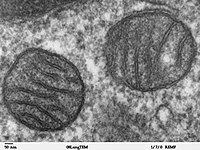
Photo from wikipedia
Background The typical single-chromosome mitochondrial (mt) genome of animals has fragmented into multiple minichromosomes in the lineage Mitodivisia, which contains most of the parasitic lice of eutherian mammals. These parasitic… Click to show full abstract
Background The typical single-chromosome mitochondrial (mt) genome of animals has fragmented into multiple minichromosomes in the lineage Mitodivisia, which contains most of the parasitic lice of eutherian mammals. These parasitic lice differ from each other even among congeneric species in mt karyotype, i.e. the number of minichromosomes, and the gene content and gene order in each minichromosome, which is in stark contrast to the extremely conserved single-chromosome mt genomes across most animal lineages. How fragmented mt genomes evolved is still poorly understood. We use Polyplax sucking lice as a model to investigate how tRNA gene translocation shapes the dynamic mt karyotypes. Results We sequenced the full mt genome of the Asian grey shrew louse, Polyplax reclinata . We then inferred the ancestral mt karyotype for Polyplax lice and compared it with the mt karyotypes of the three Polyplax species sequenced to date. We found that tRNA genes were entirely responsible for mt karyotype variation among these three species of Polyplax lice. Furthermore, tRNA gene translocation observed in Polyplax lice was only between different types of minichromosomes and towards the boundaries with the control region. A similar pattern of tRNA gene translocation can also been seen in other sucking lice with fragmented mt genomes. Conclusions We conclude that inter-minichromosomal tRNA gene translocation orientated towards the boundaries with the control region is a major contributing factor to the highly dynamic mitochondrial genome organization in the parasitic lice of mammals.
Journal Title: BMC Genomics
Year Published: 2021
Link to full text (if available)
Share on Social Media: Sign Up to like & get
recommendations!